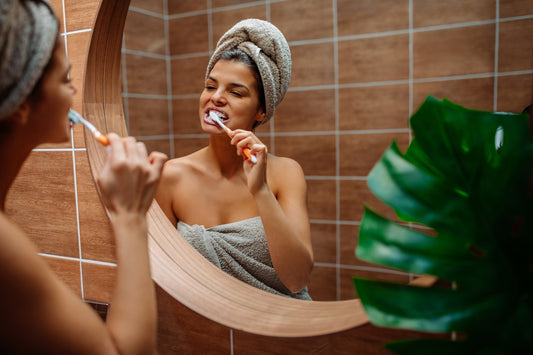Our gut microbes are established in our early years and appear to be remarkably resilient. However, the balance of bacteria can change – for good or ill. If your gut bugs are not benefiting your health, how can you change them for the better?
1. Feed them right
Eat whole, unprocessed, unrefined foods: cut out the sugar and refined carbs, reduce alcohol consumption, and increase the high-fibre vegetables. You’ll increase your bacterial diversity through ensuring a good variety in foods you eat. Our gut bacteria need the right foods to live on. They have adapted to use our cast-off foods, those that we cannot digest and absorb ourselves, which mainly means fibre! But not just any fibre, in particular our gut bacteria thrive on so-called soluble fibre which can be fermented.1,2 These kinds of fibres are found in particularly high amounts in leeks, onions, garlic, asparagus, chicory root, Jerusalem artichoke, legumes, radish, carrots, cucumber, peppers, beetroot, cabbage, sweet potato. Some fruits are also rich in prebiotic fibres, such as tomatoes, apples, berries, bananas. Finally, many seeds also contain fibres to feed the gut bacteria, such as chia seed, hemp seed, flax seed, pumpkin seeds, wild rice, quinoa and even cocoa beans.
Eating a wide range of these foods will be most beneficial as they each have slightly different types of fibre so to encourage the growth of a great diversity of gut bacteria, it’s important to eat a good variety of foods to support them. The greater the diversity in types of gut bacteria, the greater benefit to our health.1,2 You don’t have to eat 30 or more different kinds of plant foods every day, however! The variety in your food may be obtained by following seasonal variations in available foods. There is even some evidence that eating seasonally provides extra benefits because these foods will have been picked in the best possible condition.
On the other hand, if you feed them the wrong foods, you’ll encourage growth of the more unfriendly kinds of micro-organisms.3,4 Sugary foods and drinks, refined carbohydrates, alcohol, even artificial sweeteners can tip the balance towards the unwanted bugs.
Changes to what you eat and drink can have rapid effects: even within 24 hours. Drinking alcohol can encourage growth of the Candida fungus within 2 hours. However, in most cases these changes will be fairly transient. To create a long-lasting change could take 6 months.
Caution: if you suffer from IBS type symptoms and experience bloating, and pain on eating high-fibre foods, you’ll need to work on other aspects of gut health before increasing these fermentable foods.5
2. Probiotics
Add fermented foods to your diet. You don’t need to take probiotic supplements if you are eating a healthy diet (as in Step 1). Again, variety is a good idea so choosing, for example, sauerkraut one day, yogurt another.
What about probiotics – foods or supplements containing live bacteria? Can they change the population of your gut bugs? Yes, there is plenty of scientific research to show that probiotics can alter the microbiome.6-15 However, the way in which probiotics work may not be what you might think. When you take a probiotic food or food supplement, the bacteria it contains may not necessarily take up residence in your gut. While some will form a growing population, others they may live only temporarily, others may not survive to form a colony at all. Nonetheless, whether they survive in your gut or not, they can still have an impact on the balance of your gut microflora.You may have read articles claiming that probiotic foods and supplements are not useful because the micro-organisms do not survive in the gut, but studies have found that the presence of even dead bacteria can influence the microbiome by affecting how our body’s immune system responds. It is clear that consuming probiotics does affect the balance of the gut microflora regardless of whether or not the probiotic organisms survive long-term.The most widely studied probiotic bacteria are the lactobacilli (e.g., Lactobacillus acidophilus)16,20 and the bifidobacteria (e.g., Bifidobacterium brevis),18,21-24 and there is one probiotic yeast, Saccharomyces boulardii,16,31-35 which has also been very well researched.
You don’t need to take a probiotic supplement to gain advantage of probiotic bacteria: these organisms are commonly found in fermented foods.32 For example, fermented dairy contains lactobacilli and bifidobacteria; sauerkraut and kimich contain lactobacilli; kefir contains probiotic yeast species.
Caution: If you choose to take a probiotic supplement, change products regularly (e.g., from Lactobacillus to Bifidobacterium), and stop taking the probiotics once your symptoms have improved.
3. Exercise
Include daily exercise in your lifestyle but don’t overdo it! If you enjoy endurance exercise, be sure to take especial care of your gut health.You may be surprised to know that exercise can also influence the balance of your gut microbes.33,36 However, extreme endurance exercise can adversely affect gut health.37
4. Don't kill the good guys!
Antibiotics can have a positive and negative effect on your gut bacteria. Be mindful of this, and only take antibiotics under the direction of your doctor. Antibiotics can have a dramatic impact on your gut microbes.38-42 Whether you are taking antibiotics with the intention of altering your gut bugs or to clear a different infection, when you take these medicines, you will undoubtedly be making changes. How big a change and whether the end result is what you wanted will depend on a lot of factors, including the type, dose and duration of the antibiotics used, the balance of your microbiome before starting the course of antibiotics and the state of your immune system. A course of antibiotics will not kill all of your gut bacteria, but they may have a long-term effect on the balance – studies have found in some cases, the effects can be seen for 2 years or more after finishing the course.43,44 On the other hand, if you are taking antibiotics with the aim of killing unwanted gut bacteria, the treatment is likely not to kill all the target organisms, but simply reduce the load sufficiently that your immune system can (hopefully) deal with the remainder. The treatment may be more effective at killing some bacteria than others. Thus, a course of antibiotics may have unpredictable effects on your gut bugs.45,46
5. Other Medicines
Be cautious about taking medications unnecessarily. Make sure your doctor reviews your medications regularly and do not buy over-the-counter medicines without medical advice. A wide range of medicines apart from antibiotics can adversely affect the gut microbiome.47 In particular, types of antidepressants, diabetes medications, antacids, nonsteroidal anti-inflammatory drugs and antipsychotic medicines have been found to affect our gut microbes.
6. Oral Hygiene
Look after your oral microbiome. Avoid using toothpastes and mouthwashes that may kill off the helpful bacteria. Instead, prevent growth of unwanted bacteria by starving them of sugary foods and drinks which they thrive on. Remember that the gut starts in the mouth! The oral microbiome is equally as important as the microbes living further down.48,50 What you put in your mouth can affect the oral microbiome and beyond. Consider whether antibacterial mouthwash or toothpaste might upset the balance of your microbiome: there may be unexpected consequences to your health.51,52
A great alternative to mouthwash is “oil pulling”. Swoosh about a tablespoon of coconut or sesame oil around your mouth, ideally first thing in the morning for about 5 minutes if you can manage it. The oil penetrates into crevices that flossing doesn’t reach. Don’t swallow the oil! Spit it out into a tissue then flush down the toilet. You can brush your teeth afterwards with non-antibacterial toothpaste if you want.
If you're looking to optimise your gut health, digestive enzymes can be a great way to improve digestion. Here's 10% off our Digest Complex & Digest Bitters to help you on your way. Use code BLOG at checkout.








